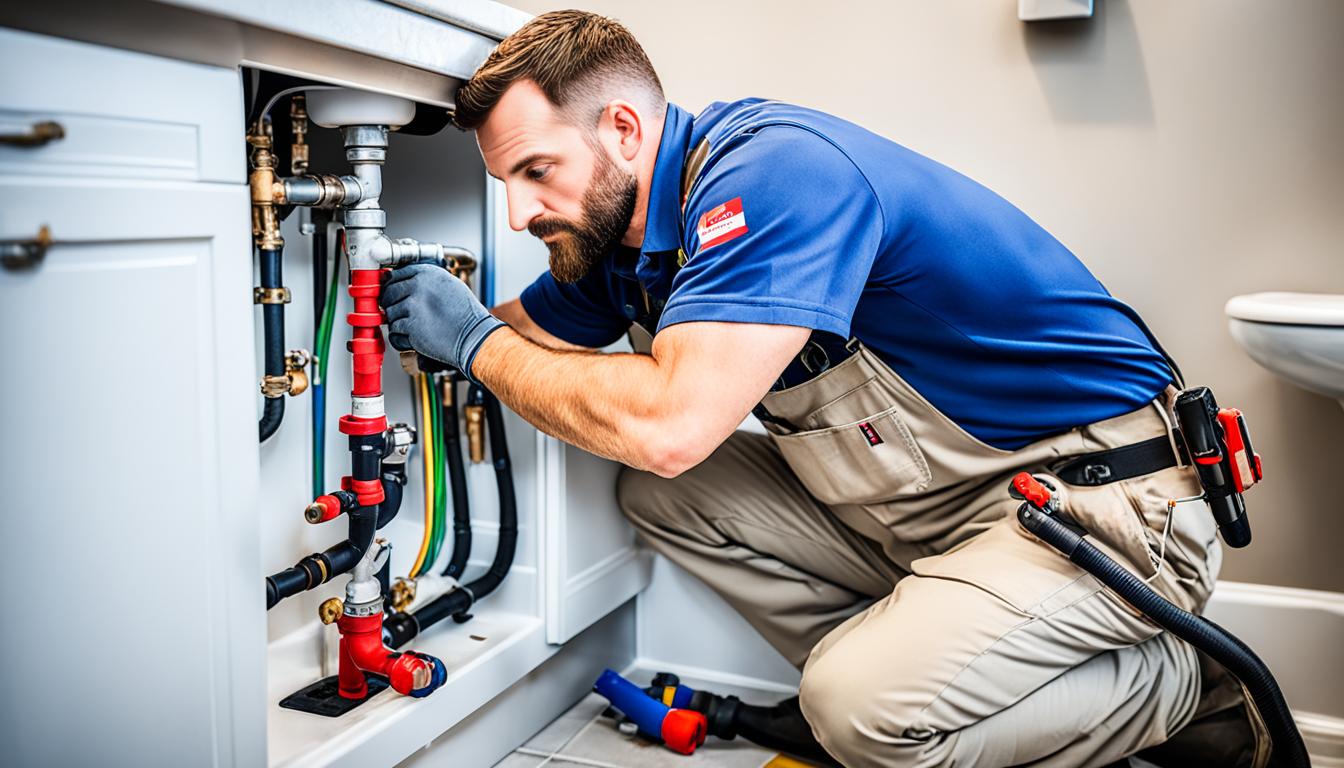Imagine managing 50% more service calls without hiring extra office staff. Modern field service platforms make this possible by centralizing dispatch, customer interactions, and billing in one place. These cloud-based systems help teams coordinate technicians, track inventory, and resolve issues faster than traditional methods.
ServiceTitan and similar tools enable companies to scale their field teams without physical office expansions. Real-time GPS tracking ensures customers get accurate arrival times, while automated job assignments reduce scheduling errors. This efficiency often translates to 4.8-star ratings on review platforms as clients appreciate timely updates and organized service.
Detailed reporting integrations with accounting programs like QuickBooks turn raw data into actionable insights. Managers can spot trends in team performance or seasonal demand spikes, adjusting strategies week-to-week. Mobile apps let technicians capture signatures, update job statuses, and share photos directly from their vans.

Key Takeaways
- Centralized systems handle dispatching, CRM, and payments in real time
- GPS tracking improves arrival estimates and customer trust
- Automated workflows reduce paperwork by up to 80%
- Live dashboards help managers optimize team productivity
- Integrated accounting tools simplify financial decisions
Introduction
What if your team could handle twice as many jobs without chaos? Modern tools designed for plumbing businesses are transforming how teams operate, turning scattered processes into smooth workflows. By replacing paper-based systems with digital solutions, companies gain real-time visibility between field crews and office teams.
Manual data entry and misplaced invoices often eat into profits. Specialized platforms tackle these headaches head-on. They automate repetitive tasks, letting staff save time while reducing errors. For example, dispatchers can assign jobs in seconds, and technicians update statuses from their phones.
Many plumbing service providers still rely on sticky notes and spreadsheets. This leads to missed appointments and frustrated customers. Centralized systems fix these gaps by syncing schedules, customer histories, and inventory levels. Teams resolve issues faster, and managers spot bottlenecks through live dashboards.
Adopting these tools isn’t just about keeping up—it’s about thriving. Plumbing businesses using integrated platforms report fewer callbacks and quicker payments. With features like mobile invoicing and instant reporting, teams focus on what matters: delivering exceptional plumbing service without the administrative grind.
Ready to save time and boost efficiency? Let’s explore how modern solutions empower plumbing businesses to work smarter, not harder.
Understanding the Needs of Plumbing Businesses
How do modern service providers stay ahead when customer expectations evolve daily? Many teams still grapple with outdated workflows. Paper schedules, handwritten invoices, and missed dispatches drain time and frustrate customers.
Current Industry Challenges
Manual methods create bottlenecks. Dispatchers waste hours coordinating crews via phone, while technicians juggle paper maps and last-minute changes. Nearly 40% of field teams report scheduling errors due to miscommunication.
Inventory mismatches compound delays. Without real-time tracking, technicians often arrive without critical parts. Customers then face rescheduled appointments—a recipe for negative reviews.
Emerging Market Trends
Cloud platforms like ServiceTitan now centralize operations. Live GPS tracking reroutes crews around traffic, while automated alerts notify customers about arrival times. Mobile apps let technicians update job statuses instantly.
Integrations with accounting systems slash paperwork. For example, Service Fusion syncs invoices with QuickBooks, reducing payment delays by 65%. These tools help teams focus on quality service, not administrative chaos.
Exploring Plumbing Business Software and Its Benefits
Think of a tool that acts as both a command center and communication hub for field teams. Modern platforms like Jobber combine scheduling boards, GPS trackers, and customer portals into one interface. This architecture lets dispatchers drag appointments across calendars while automatically alerting technicians about new jobs.
These systems cut errors by syncing updates instantly. When a customer reschedules, the change reflects on everyone’s devices—no more missed calls or double-booked slots. One company using ServiceTitan reduced scheduling mishaps by 73% within six months.
Real-time updates keep crews aligned. Office teams see technician locations on maps, while field staff receive instant alerts about priority jobs. A dashboard in FieldPulse, for example, shows which tasks are delayed and reroutes nearby teams to fill gaps.
Everything connects—from dispatching to billing. After completing a job, technicians can snap photos of their work and send invoices through mobile apps. Customers get payment links via text, speeding up cash flow. One operator reported closing 22% more jobs weekly after adopting this approach.
Practical tools make daily operations smoother. Features like automated checklists ensure nothing gets overlooked, while CRM integrations track customer preferences. These details help teams deliver faster, more personalized service without juggling multiple apps.
Essential FSM Features for Plumbing Businesses
What separates top-performing teams from those stuck in daily chaos? The answer often lies in choosing tools that align with modern operational demands. Centralized dispatch systems and seamless communication channels form the backbone of efficient service delivery.
Smart Dispatching That Saves Time
Instant job notifications eliminate phone tag between offices and technicians. Routing algorithms analyze locations and traffic, assigning the nearest available crew. This reduces drive time by 15-20% while keeping schedules packed.
Dynamic boards automatically adjust when emergencies arise. One company using GPS-enabled routing handled 31% more jobs monthly without hiring extra staff. Real-time updates ensure everyone—from dispatchers to clients—stays informed.
Clear Communication Builds Trust
Automated texts notify customers about technician details and arrival windows. Photos and notes shared via mobile apps give clients visibility into work progress. Transparency reduces callback requests by 42%, according to recent field data.
Integrated payment systems sync completed jobs with accounting software. Invoices generate automatically, pulling data from parts used and labor hours logged. QuickBooks integrations cut billing errors by 78%, ensuring faster payments.
These features create a ripple effect: smoother operations, happier clients, and more time to focus on quality service. When teams communicate clearly and act swiftly, growth follows naturally.
Streamlining Dispatch and Scheduling
When every minute counts, aligning teams becomes mission-critical. Modern tools transform chaotic workflows into precision operations by connecting office staff and technicians instantly. This shift eliminates guesswork while keeping everyone focused on urgent priorities.
Instant Job Notifications
Real-time alerts ping phones and tablets the moment new requests arrive. Dispatchers assign tasks with one click, and crews confirm assignments without phone calls. One company using FieldEdge’s mobile app reduced response delays by 41% through instant updates.
These notifications include job details like location maps and customer history. Technicians review specs en route, arriving prepared with the right tools. Managers track confirmations through dashboards, ensuring no task slips through cracks.
Real-Time Technician Routing
Smart algorithms analyze traffic patterns and crew locations to optimize routes. GPS tracking in tools like ServiceTitan cuts drive times by 30% while balancing workloads. Teams handle more jobs daily without overtime costs.
Dynamic rerouting kicks in when emergencies arise. If a technician finishes early, the system assigns nearby tasks automatically. This flexibility helps managers adapt to last-minute changes while maintaining customer trust.
Integrated scheduling boards display real-time progress markers. Dispatchers spot delays instantly and redistribute tasks to available crews. Automated updates keep customers informed, reducing frustration and callbacks.
By slashing manual management tasks, teams reclaim hours weekly. Less time spent on paperwork means more attention to field excellence and client relationships. It’s efficiency that fuels growth—one optimized route at a time.
Enhancing Customer Communication and Satisfaction
Ever wondered how top service teams keep clients smiling even during hectic days? Clear communication bridges gaps between expectations and reality. Modern tools ensure customers feel informed—and crews stay empowered to deliver.

Automated Customer Updates
Automated reminders via text or email reduce no-shows by 28%. Systems like ServiceTitan send GPS-tracked arrival times, letting clients plan their day. Real-time job status updates cut support calls by 40%, freeing staff for critical tasks.
These features build trust before technicians arrive. Customers appreciate knowing who’s coming and when. Post-service surveys trigger automatically, capturing feedback while experiences stay fresh.
Seamless Field-to-Office Connections
Technicians share photos and notes through mobile apps. Office teams instantly access these details to answer client questions. One company resolved 90% of follow-up inquiries within minutes using this approach.
Robust scheduling tools sync field data with dispatchers. If a job runs long, the system alerts the next customer proactively. Integrated invoicing sends payment links instantly—no more waiting for paper bills.
Teams using these methods see 4.9-star reviews climb by 35%. Happy clients return—and refer others. It’s how service excellence becomes your reputation.
Simplifying Invoicing and Payment Processing
What if billing could boost customer loyalty? Modern tools turn this possibility into reality by transforming clunky paperwork into smooth digital exchanges. Integrated invoicing features let teams create professional bills in seconds—just snap a job photo, select parts used, and hit send.
Mobile apps take this further. Technicians process credit cards or digital wallets like Apple Pay right from their vehicles. One provider using FusionPay reported 89% of clients paying instantly through text links. No more waiting for checks or chasing overdue balances.
These systems sync seamlessly with office software. Completed jobs automatically populate accounting platforms like QuickBooks, eliminating duplicate entries. Managers track payments through dashboards that highlight pending invoices or seasonal cash flow trends.
Automation slashes errors dramatically. Pre-filled customer details and pricing tables ensure accuracy, while reminders nudge clients about upcoming due dates. One company reduced billing disputes by 78% after switching to automated systems.
Flexible payment options keep customers happy. Offer Stripe, PayPal, or ACH transfers through the same app. Custom invoices with company logos build trust—clients appreciate polished documentation that matches your brand’s professionalism.
When money moves faster, teams grow smarter. Instant deposits mean fewer cash crunches, and real-time reports help spot profitable services. It’s billing without the headache—just swift, secure transactions that keep everyone smiling.
Integrating with Accounting and Reporting Tools
How much time could your team save if financial reports wrote themselves? Modern systems bridge field operations and back-office tasks by syncing job details with accounting platforms automatically. This connection turns hours of manual work into seamless background processes.
QuickBooks Seamless Sync
Platforms like ServiceTitan integrate directly with QuickBooks, eliminating duplicate entries. Completed jobs trigger invoice generation, pulling data from parts used and labor hours logged. One provider reduced billing errors by 78% while cutting payment delays in half.
Mobile access lets managers approve expenses or view cash flow from anywhere. Payroll integrations with ADP automatically calculate taxes and overtime, saving 12 hours monthly on administrative tasks. These options keep financial records accurate without spreadsheet headaches.
Advanced Reporting Insights
Live dashboards transform raw numbers into actionable trends. Track profit margins per job type or monitor seasonal demand spikes across zip codes. Custom reports in tools like FieldEdge compare crew performance, helping optimize schedules and resource allocation.
Third-party integrations add depth—connect pricing guides like The New Flat Rate to ensure quotes align with market rates. With real-time data shaping decisions, teams spot growth opportunities faster than ever.
Mobile Applications: Empowering Field Technicians
Field crews no longer need to circle back to the office for updates—mobile apps put critical details in their palms. These tools deliver instant job alerts, GPS navigation, and customer histories to smartphones. Technicians review specs en route, arriving prepared with the right parts and pricing guides.
Real-time maps track crew locations, helping dispatchers assign the nearest available team. One provider using ServiceTitan’s mobile app reduced drive times by 30% through optimized routing. Automated alerts notify offices when jobs start or finish, keeping schedules tight.
Digital work orders eliminate paper shuffling. Technicians access pricing databases and inventory levels mid-job, avoiding return trips for missing supplies. Snap photos of completed work, collect e-signatures, and send invoices—all before leaving the driveway.
These apps strengthen team coordination. Dispatchers see real-time progress markers and redistribute tasks if delays occur. A Florida company cut callback rates by 37% after adopting mobile checklists that ensure no step gets missed.
Empathy meets efficiency here. Crews facing rush-hour traffic get rerouted instantly, while after-hours emergencies trigger automatic overtime pay alerts. One technician shared: “I finish 2-3 extra jobs daily without stressing about paperwork.”
When everyone stays connected, customers win. Real-time tracking updates build trust, and instant payment options boost cash flow. It’s about giving field stars the tools to shine brighter.
Leveraging Fleet Tracking for On-the-Go Operations
How do teams always stay one step ahead of schedule? Real-time GPS tracking gives contractors eyes on every vehicle. Systems like Force Fleet Tracking show exact locations, fuel levels, and job progress through live dashboards.
Route optimization slashes drive times by 30% in crowded cities. Dispatchers assign the nearest crew using traffic-aware maps. One company saved $18,000 yearly on fuel by eliminating unnecessary detours.
Accurate arrival estimates build customer trust. Clients receive texts with technician photos and live ETAs. This transparency helped a Colorado team boost on-time rates to 97%—earning 4.9-star reviews.
Detailed information reshapes scheduling. Managers compare job durations with travel times, adjusting plans as delays occur. Historical data identifies patterns, like which neighborhoods need more midday coverage.
Integrations with tools like Jobber sync fleet information with service calendars. Over 250,000 pros use this approach to keep jobs flowing smoothly. Instant rerouting handles emergencies without missing beat.
For contractors, these systems mean fewer panicked calls and more controlled workflows. Live updates ensure everyone—from office staff to field teams—operates with the same estimates and priorities. It’s how service excellence becomes routine.
Customizable Solutions to Fit Unique Business Needs
Why settle for one-size-fits-all tools when your operations deserve better? Modern platforms adapt like clay, molding features to match specific workflows. This flexibility proves vital for companies managing varied job types or seasonal demand swings.
Flexible Service Options
Modular designs let teams pick what matters. Need dynamic scheduling but skip inventory tracking? Platforms like Service Point Pro allow à la carte selections. This approach prevents paying for unused features while scaling as needs evolve.
Custom invoicing templates simplify payments. Companies can highlight preferred methods like Stripe or ACH transfers. One provider using Job-Dox’s tools reduced billing errors by 78% through tailored rate cards and auto-populated client details.
Enhanced communication bridges office-field gaps. Dispatchers share real-time updates through branded SMS templates. Customers appreciate consistent messaging, while crews get instant alerts about priority jobs. A Texas team boosted satisfaction scores by 41% using this strategy.
Integrations keep workflows smooth. Sync calendars with Google Workspace or connect CRM tools to QuickBooks. These connections help businesses maintain momentum without app-hopping. As one manager noted: “We finally stopped drowning in duplicate data entry.”
Growth thrives when solutions fit like gloves. Whether optimizing routes for urban density or crafting rural service packages, adaptable systems empower smarter decisions. Start shaping your toolkit today—your unique challenges deserve equally unique answers.
Automation: Reducing Manual Data Entry and Errors
Ever feel like your team spends more time typing than fixing? Modern tools tackle this frustration head-on by automating repetitive tasks. Field teams using these systems report 67% fewer data entry mistakes compared to manual methods.
Automated invoicing transforms billing from chore to click. When technicians complete jobs, systems generate accurate bills using pre-loaded pricing and labor rates. One provider slashed payment delays by 58% while reducing invoice errors to near zero.
Order processing becomes seamless with digital workflows. Suppliers receive automatic restock alerts when inventory dips below set levels. Crews get real-time updates about parts availability, eliminating “sorry, we’re out” moments during appointments.
System-generated details ensure precision in every record. Customer histories, service notes, and equipment specs update automatically after each visit. Dispatchers spot patterns through dashboards—like which neighborhoods need extra drain snakes every spring.
Office teams gain hours weekly once freed from paperwork. These saved minutes turn into customer check-ins or growth planning. A Florida company used this reclaimed time to launch a loyalty program, boosting repeat bookings by 33%.
Integration with tools like QuickBooks turns financial chaos into clarity. Completed jobs sync instantly with accounting platforms, while custom reports highlight profitable services. It’s how smart automation helps teams work less and achieve more.
Enhancing Job Estimation and Project Management
How can precise cost predictions transform your project outcomes? Modern estimation tools analyze material costs, labor rates, and past project history to create detailed budgets. These systems generate line-item breakdowns instantly, replacing guesswork with data-driven proposals.
Integrated project management platforms track every phase using historical patterns. Teams review timelines from similar past jobs to set realistic milestones. One provider using Knowify reduced budget overruns by 62% through this approach.
Client portals accelerate approvals by letting customers review estimates digitally. Homeowners sign off on scopes of work through an online portal—no more waiting for faxes or emails. This cuts approval times from days to hours while keeping everyone aligned.
Seamless integration between estimation and management tools creates a single source of truth. When a plumbing company’s quote gets approved, it automatically becomes a project plan with assigned tasks. Crews access specs, timelines, and customer notes in one place.
Practical example: A contractor shares a $12,000 bathroom upgrade estimate via portal access. The client approves it, triggering automatic material orders and crew assignments. Real-time updates keep both parties informed as work progresses.
This integrated approach turns estimates into action plans without manual re-entry. Teams build trust through transparency while managers use historical data to refine future bids. It’s how precision meets productivity.
Competitive Edge Through Advanced Technology
Staying ahead in service industries requires more than skilled teams—it demands tools that evolve faster than customer expectations. Modern solutions streamline operations through intuitive design, letting crews focus on quality work instead of clunky interfaces. Teams adopting these platforms often see faster onboarding, as user-friendly layouts reduce training time by up to 65%.
Robust reporting tools turn raw data into growth strategies. Live dashboards highlight trends like peak service hours or technician efficiency gaps. One company used these insights to boost same-day bookings by 40% while cutting fuel costs through AI-powered route optimization.
Meeting evolving needs means choosing systems that scale. Top platforms offer customizable workflows—like adjusting job templates for emergency calls or seasonal maintenance. Features like mobile photo uploads and automatic client notifications keep teams agile as priorities shift.
Leaders distinguish themselves through smart integrations. CRM sync ensures customer histories follow every job, while automated inventory alerts prevent supply shortages. These upgrades create smoother experiences for both staff and clients—proving innovation isn’t optional, but essential for long-term success.
Real-Life Transformations in Plumbing Businesses
Picture a crew completing 30% more jobs monthly without added stress. That’s exactly what happened when a Midwest team adopted ServiceTitan’s solution. Their dispatchers automated maintenance reminders, while GPS routing slashed drive times by 22%. Customers received real-time ETAs, boosting satisfaction scores to 4.9 stars.
Another provider using Service Fusion tackled seasonal demand spikes. Their new system auto-scheduled filter replacements and pipe inspections during slow periods. This proactive maintenance approach reduced emergency callouts by 41%—freeing crews for higher-value projects.
Clear communication solved common pain points. One company addressed client questions upfront by sharing technician profiles and service checklists via text. This transparency cut callback rates by 35% while streamlining maintenance workflows.
Adoption hurdles faded as teams saw results. A Florida operator initially had questions about data migration but found the solution intuitive. Within weeks, they tracked inventory in real time and reduced parts waste by 28%. Their dashboard now highlights profitable services, guiding smarter investments.

These stories show what’s possible. Whether optimizing maintenance schedules or answering customer questions faster, the right tools create ripple effects. Imagine your team achieving similar wins—less chaos, more growth, and clients who rave about your reliability.
Conclusion
Modern service teams are rewriting the rulebook through synchronized tools that eliminate bottlenecks. Integrated systems slash manual entry by automating job updates, inventory tracking, and payment processing. This shift lets crews focus on quality work instead of paperwork.
Centralized dispatch and real-time tracking cut response times while boosting customer trust. Automated invoicing speeds up cash flow, and live dashboards highlight growth opportunities. Teams using these solutions report measurable progress in daily productivity and client satisfaction.
Advanced platforms also simplify data entry through mobile apps and cloud sync. Field crews log job details instantly, reducing errors and delays. Managers gain insights to refine schedules and resource allocation week-to-week.
For service providers ready to drive progress, these tools offer a clear path forward. Less time spent on repetitive tasks means more capacity for strategic growth. Explore how tailored solutions can transform your operations—from optimized routes to happier clients.
Take the first step today toward smoother workflows and scalable success. Your team deserves tools that turn challenges into opportunities for operational progress.
See how FieldAx can transform your Field Operations.
Try it today! Book Demo
You are one click away from your customized FieldAx Demo!
FAQ
How can specialized tools help overcome common challenges in the industry?
Modern solutions address issues like delayed responses, miscommunication, and manual errors by automating scheduling, streamlining dispatch, and providing real-time updates for teams and customers.
What features improve dispatch efficiency for service teams?
Instant job alerts, GPS-based routing, and dynamic scheduling ensure technicians arrive faster. Real-time updates also help adjust routes for traffic or urgent requests.
Can customers receive automatic updates about their service appointments?
Yes! Automated SMS or email notifications keep clients informed about arrival times, delays, or completion updates, reducing calls to the office and boosting satisfaction.
Are there mobile-friendly options for on-site invoicing?
Absolutely. Technicians can generate invoices directly from their devices, accept digital payments, and send receipts instantly—no more waiting for paper bills or chasing payments.
Does this integrate with accounting platforms like QuickBooks?
Many systems sync seamlessly with QuickBooks, ensuring financial data flows automatically between field operations and accounting teams, saving hours of manual entry.
How do mobile apps support technicians in the field?
Apps provide access to job details, customer history, and parts inventory. They also allow photo uploads, digital signatures, and instant communication with dispatchers.
Can managers track vehicles or optimize routes in real time?
Yes. GPS fleet tracking helps monitor locations, reduce fuel costs, and reroute teams based on traffic or priority jobs—all from a central dashboard.
Is it possible to customize workflows for unique service needs?
Flexible platforms let you tailor checklists, pricing templates, and service packages to match specific workflows, whether for repairs, installations, or maintenance plans.
How does automation improve accuracy in daily tasks?
By auto-filling client data, generating reports, and syncing information across teams, automation minimizes typos, duplicate entries, and missed steps in processes.
Can these tools create detailed estimates quickly?
Yes! Pre-built templates with labor rates, material costs, and tax calculations let technicians create professional quotes on-site in minutes, improving win rates.
Author Bio
Co-Founder & CMO at Merfantz Technologies Pvt Ltd | Marketing Manager for FieldAx Field Service Software | Salesforce All-Star Ranger and Community Contributor | Salesforce Content Creation for Knowledge Sharing






